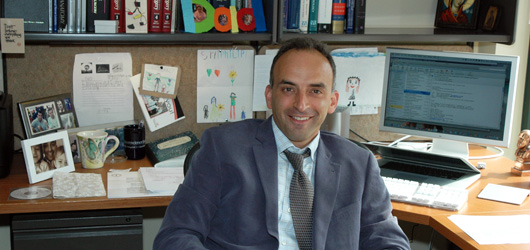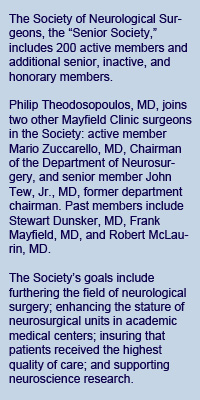
The esteemed Society of Neurological Surgeons is “a little bit of a skull and bones society,” according to Philip Theodosopoulos, MD, who as a Mayfield Clinic neurosurgeon clearly knows his skulls and bones. There is the nomination, then the quiet approvals, the wait, the additional wait, the vote, and then, magically, a profusion of handshakes and glowing smiles. “You have people coming out of the meeting and congratulating you, but there’s no official announcement,” Dr. Theodosopoulos says.
But the importance of the “Senior Society” – the oldest neurosurgical society in the world — is no secret, and it provides a new platform for the contributions that Dr. Theodosopoulos (pronounced THEE-oh-duh-SOP-uh-loss) is making as Associate Professor and Director of the Neurosurgical Residency Program at the University of Cincinnati. Only three years into his directorship of what has long been one of America’s most prestigious residency programs, he is drawing national attention for changes he is making in how young neurosurgeons learn their craft.Dr. Theodosopoulos, who also serves as Director of the Division of Skull Base Surgery at UC, is excited about his recent inclusion in this rarefied group of 200 active members, not so much because of the honor, but because it allows him to elevate his contributions to the field. “It allows me to share ideas with this influential group and to refocus our efforts into more of a national level,” he says.
 Dr. Theodosopoulos has already made a dual impact in the education of neurosurgery residents, young men and women who have completed medical school and are immersed in a rigorous six-year training program to become neurosurgeons. After a recent 5-year review of UC’s Department of Neurosurgery training program, Residency Review Committee (RRC) officials were so impressed that they scheduled the next review for 12 years hence while commending the program’s two new initiatives:
Dr. Theodosopoulos has already made a dual impact in the education of neurosurgery residents, young men and women who have completed medical school and are immersed in a rigorous six-year training program to become neurosurgeons. After a recent 5-year review of UC’s Department of Neurosurgery training program, Residency Review Committee (RRC) officials were so impressed that they scheduled the next review for 12 years hence while commending the program’s two new initiatives:
The first is the requirement that each resident perform two observed, adjudicated surgeries before a faculty member each year. The faculty member then provides detailed feedback according to previously defined parameters. “The residents are graded on their preoperative evaluation, positioning in the operating room, post-operative planning, how they dealt with complications,” says Dr. Theodosopoulos. “Then we drill that down further to certain technical things, such as dexterity, 3D understanding, anatomical knowledge, confidence.”
Dr. Theodosopoulos’s second initiative involves mid-point written evaluations during each four-month rotation a neurosurgical resident completes. “It sounds elementary,” Dr. Theodosopoulos says, “but the RRC reviewer — who has reviewed 40-some programs a year for 20-some years — had never seen it before. Why? Because these are initiatives that are difficult to implement and that take a lot of effort from an exceptionally busy faculty.”
In the past, residents have received formal grading and feedback only at the end of each rotation, rather than at regular intervals. “If, at the end of the year, you tell a young surgeon, ‘you’re not doing well, you’re not up to par,’ this doesn’t help anyone,” Dr. Theodosopoulos says. “It’s the most unfair way to educate. Residents will hear, ‘I’m not good, I’m not good.’ That was the old way to train people, and it doesn’t have any place in the modern education of surgeons. So instead, we take the crux of someone’s weakness and say we can improve it.
“Frankly, I see my job not so much as teaching the people who are already great but rather the people who have trouble,” he continues. “How do we take those people who have trouble and make them better? Someone who has trouble, that’s the challenge – and that’s where the great gains are to be made.”
The Residency Review Committee reviewer was so impressed with these initiatives that he asked permission to include them in the Accreditation Council for Graduate Medical Education Notable Practices, which is published on their Web site. The gesture, Dr. Theodosopoulos says, puts the UC Department of Neurosurgery “on the map in a new way.”
–Cindy Starr